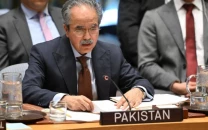Intangible hidden dimension Blending two cultures
Ali explores layers of socio-political scenarios by filtering camouflaging nature of history

Ali explores layers of socio-political scenarios by filtering the camouflaging nature of history through his work. PHOTOS: HAFSAH SARFRAZ
Art has the tendency to bridge borders and blend cultures. This was evident in a recent exhibition titled ‘Hybrid Identity’ featuring unique works of Syed Faraz Ali at Nomad Art Gallery.
One look at his work and viewer can sense that he enjoys exploring layers of socio-political scenarios by filtering the camouflaging nature of history, which is precisely the crux of most of his work. His work seems to be in a constant struggle to find the intangible hidden dimension.
Ali is a Sydney-based artist and has exhibited at group and solo exhibitions in Pakistan and abroad. With several awards to his credit, he uses his artwork to express the blend in the two different countries where his life straddles.
In this exhibition he has used stunning mediums like watercolour, pigment ink and powder, coffee stain, and gold leaf.
The exhibition was inaugurated by Australian High Commissioner Margaret Adamson on Wednesday. The artist’s work has used dominant symbols of Australian culture and blended them in his work, she said. “Much like the works of Eva Hoffman who wrote a novel ‘Lost in Translation,’ Faraz’s work also tries to answer questions like who am I and where am I? His work is not just powerful but also extremely meaningful because he has used Australian and Afghan elements, animals and other significant figures to blend in his work,” she said.
The artist, in his statement, said that the Australia-Afghan relationship inspired the series of work produced. “The scale of the paintings plays a fundamental role symbolising an expression of perceived reality that provokes viewers to recognise the manipulated socio-cultural metaphors. The human form goes through metamorphosis creating an illusion, from silent conformity where vested decisions shape up the societies to human conditions which come to surface on probing deeper. The distortion of ephemeral perfection of imperfect beauty questions the socio-political norms of cultural imprints,” he said.
NAG Director Nageen Hyat told The Express Tribune that Ali’s work was exceptionally powerful not just because of the idea but also because his work was selected and uncensored. “His paintings provoke the viewer to think about his original and symbolic imagery and content. Through his work Faraz has been raising pertinent questions on identity and socio-political issues around the region and at an international level,” she said.
Published in The Express Tribune, May 6th, 2016.



















COMMENTS
Comments are moderated and generally will be posted if they are on-topic and not abusive.
For more information, please see our Comments FAQ